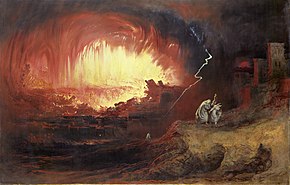Catabole: Difference between revisions
mNo edit summary |
m (→Events) |
||
| (5 intermediate revisions by the same user not shown) | |||
| Line 21: | Line 21: | ||
{{wp|Sulfur}}-rich {{wp|gypsum}} from the seabed was vaporized in large quantities and injected into the atmosphere as {{wp|aerosol}}s, triggering significant {{wp|climate change}} in an {{wp|impact winter}}. As a result, extreme weather and {{wp|harvest|harvest failures}} led to widespread {{wp|famine}}, economic distress, the outbreak of {{wp|epidemic disease}}s such as {{wp|cholera}} and the {{wp|bubonic plague}}, and ultimately major religious, political, and social upheaval around the world. It is estimated that about 30% to 60% of Calesia's population, and about 35% of the entire world population, were wiped out during the 1348–1353 [[Catabolic Crisis]] in the aftermath. | {{wp|Sulfur}}-rich {{wp|gypsum}} from the seabed was vaporized in large quantities and injected into the atmosphere as {{wp|aerosol}}s, triggering significant {{wp|climate change}} in an {{wp|impact winter}}. As a result, extreme weather and {{wp|harvest|harvest failures}} led to widespread {{wp|famine}}, economic distress, the outbreak of {{wp|epidemic disease}}s such as {{wp|cholera}} and the {{wp|bubonic plague}}, and ultimately major religious, political, and social upheaval around the world. It is estimated that about 30% to 60% of Calesia's population, and about 35% of the entire world population, were wiped out during the 1348–1353 [[Catabolic Crisis]] in the aftermath. | ||
== | ==Events== | ||
===Discovery and observation=== | |||
[[File:Heinrich III. sieht den neuen Stern über der Stadt Tivoli (Tyburtina).jpg|200px|thumb|right|[[Waldic Empire|Waldic Emperor]] [[X]] standing before [[Alsvik]] and pointing at "a new star" (decorative art from the 1348 ''[[Alsivicium]]'')]] | |||
The observation and study of {{wp|comet}}s and other star-like objects that appeared temporarily in the night sky, often referred to as "{{wp|guest star}}s", was a common practice by the time of the 14th century, particularly because of the notion that they represented {{wp|omen}}s. | |||
Some of the contemporary Calesian accounts of the discovery of the Catabolic impactor are well preserved. The oldest and most detailed account is that of Dahemian astronomer [[Julius vom Halderbruck]] from July of 1340, who described it as a "swiftly moving but pale yellow dot trailing behind [[Teleon|Maciune]]". By that time, the asteroid came within less than 0.01 {{wp|astronomical unit}}s from Teleon, allowing for adequate resolution by the naked {{wp|human eye}}. It is generally believed that this close fly-by {{wp|perturbation (astronomy)|perturbed}} its {{wp|solar orbit}} so that its passing through a {{wp|gravitational keyhole}} made impact 8 years later inevitable. | |||
Beginning in August of 1348, astronomers took notice of the asteroid once more, though no recovered account purported that these two sightings were related in any way. Fallish astronomer [[Presley Combse]] described it as "ever-growing in illuminating intensity", about the size of the planet [[Teleon|Atiner]], and a quarter the brightness of the star {{wp|Vega}}; the impactor's {{wp|apparent magnitude}} was about 3.1. Hyacinthean mathematician [[Nicodème d'Abraham]] is credited with first noticing the peculiar behavior of the object's movement across the sky and formulating the idea that "perhaps [it may] touch the earth with extraordinary speed and fiery power if [its] heavenly path is maintained." | |||
Similar and other accounts exist from scholars in Waldrich, Yingok, Razan, and Muhantara. | |||
Particularly because of the comparatively unimpressive appearance of the object in the months and days before the impact, interest in its study remained confined to a minor number of astronomers. It is debated whether royal court astronomer [[Jacobus Bolemer]] took notice of the sighting alongside vom Halderbruck in 1340 and reported it to [[Waldic Empire|Waldic Emperor]] [[X]], or whether his account of the observation of [[SN 1917]] has been falsely interpreted. | |||
===Atmospheric entry and impact=== | |||
Few who were able to witness the actual atmospheric entry of the asteroid survived the impact. Based on available information, historians believe the impact to have occured between 14:15–14:45 (2:15–2:45 pm) local time on 13 September 1348. | |||
===Immediate effects=== | |||
==Casualties and damage== | ==Casualties and damage== | ||
==Relief and reconstruction efforts== | ==Relief and reconstruction efforts== | ||
Revision as of 08:45, 4 July 2024
This article is incomplete because it is pending further input from participants, or it is a work-in-progress by one author. Please comment on this article's talk page to share your input, comments and questions. Note: To contribute to this article, you may need to seek help from the author(s) of this page. |
 The Catabolic Destruction of X (1849) by Archibald Glover, oil on canvas | |
| Date | 13 September 1348 |
|---|---|
| Time | Unknown, likely 14:15–14:45 |
| Location | 17 km (10 mi) off the coastline of X, X, X (X Sea) |
| Cause | Impact event of a small asteroid |
| Outcome | Widespread cataclysmic damage in Calesia, eastern Abaria and northern Hylasia, reduced global temperatures leading to famine (Catabolic Crisis) |
| Deaths | 2.65–3.5 million from direct impact effects; hundreds of millions due to post-impact global famine and epidemic diseases |
The Catabole, also referred to as the Catabolic Event or the Great Calamity, was the impact of a superbolide in the X Sea in the early afternoon of 13 September 1348. The presumably 350–370 m (1,210 ft) diameter, 61 million tonnes heavy near-Teleon C-type asteroid with a carbonaceous crondite-like composition, called the Catabolic impactor, struck Teleon approximately 17.4 km (10.8 mi) off the shoreline of X in X at a shallow atmospheric entry angle of 21.1 degrees and a speed relative to Teleon of 28.6 km per second (17.8 mi per second). The impact had profound effects on the course of world history.
The object impacted the sedimentary rock of the sea floor with a kinetic energy equivalent of about 1,150 megatons of TNT and instantaneously formed an impact crater 4.9 km (3.0 mi) wide and 850 m (2,789 ft) deep. The resulting emission of thermal radiation, shock waves, seismic activity, and expulsion of megatsunamis over 80 m (262 ft) tall led to the widespread devastation of communities along the surrounding coasts of the X Sea and the broader X, killing approximately 2.65–3.5 million people in one of the deadliest single natural disasters in recorded history; numerous major cities such as X and X were entirely annihilated. It was the worst natural disaster in Calesian and Hylasian history, the worst natural disaster in a millenium, and the largest impact event ever witnessed by humankind.
Sulfur-rich gypsum from the seabed was vaporized in large quantities and injected into the atmosphere as aerosols, triggering significant climate change in an impact winter. As a result, extreme weather and harvest failures led to widespread famine, economic distress, the outbreak of epidemic diseases such as cholera and the bubonic plague, and ultimately major religious, political, and social upheaval around the world. It is estimated that about 30% to 60% of Calesia's population, and about 35% of the entire world population, were wiped out during the 1348–1353 Catabolic Crisis in the aftermath.
Events
Discovery and observation

The observation and study of comets and other star-like objects that appeared temporarily in the night sky, often referred to as "guest stars", was a common practice by the time of the 14th century, particularly because of the notion that they represented omens.
Some of the contemporary Calesian accounts of the discovery of the Catabolic impactor are well preserved. The oldest and most detailed account is that of Dahemian astronomer Julius vom Halderbruck from July of 1340, who described it as a "swiftly moving but pale yellow dot trailing behind Maciune". By that time, the asteroid came within less than 0.01 astronomical units from Teleon, allowing for adequate resolution by the naked human eye. It is generally believed that this close fly-by perturbed its solar orbit so that its passing through a gravitational keyhole made impact 8 years later inevitable.
Beginning in August of 1348, astronomers took notice of the asteroid once more, though no recovered account purported that these two sightings were related in any way. Fallish astronomer Presley Combse described it as "ever-growing in illuminating intensity", about the size of the planet Atiner, and a quarter the brightness of the star Vega; the impactor's apparent magnitude was about 3.1. Hyacinthean mathematician Nicodème d'Abraham is credited with first noticing the peculiar behavior of the object's movement across the sky and formulating the idea that "perhaps [it may] touch the earth with extraordinary speed and fiery power if [its] heavenly path is maintained."
Similar and other accounts exist from scholars in Waldrich, Yingok, Razan, and Muhantara.
Particularly because of the comparatively unimpressive appearance of the object in the months and days before the impact, interest in its study remained confined to a minor number of astronomers. It is debated whether royal court astronomer Jacobus Bolemer took notice of the sighting alongside vom Halderbruck in 1340 and reported it to Waldic Emperor X, or whether his account of the observation of SN 1917 has been falsely interpreted.
Atmospheric entry and impact
Few who were able to witness the actual atmospheric entry of the asteroid survived the impact. Based on available information, historians believe the impact to have occured between 14:15–14:45 (2:15–2:45 pm) local time on 13 September 1348.
